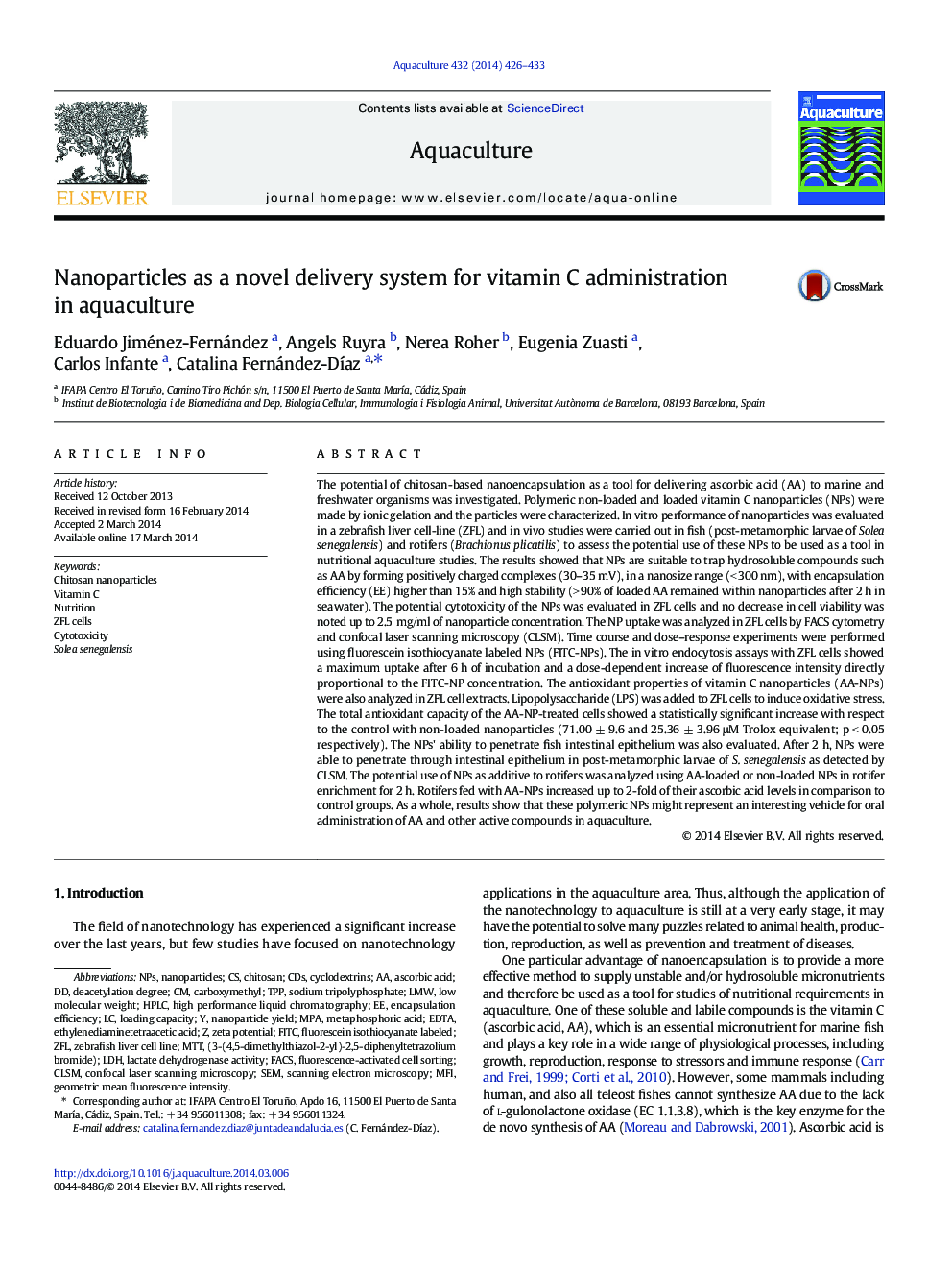| کد مقاله | کد نشریه | سال انتشار | مقاله انگلیسی | نسخه تمام متن |
|---|---|---|---|---|
| 2421759 | 1552855 | 2014 | 8 صفحه PDF | دانلود رایگان |

• In vitro assays show that nanoparticles (NPs) did not produce any toxic effect.
• These NPs entered cells and increased total antioxidant capacity.
• Ascorbic acid (AA) was loaded into NPs and formed a stable complex.
• After two hours in seawater at 20 ºC, at least 90 % of AA remains within NPs.
• Rotifers enriched with AA-NPs showed optimal AA content to be used as larvae prey.
The potential of chitosan-based nanoencapsulation as a tool for delivering ascorbic acid (AA) to marine and freshwater organisms was investigated. Polymeric non-loaded and loaded vitamin C nanoparticles (NPs) were made by ionic gelation and the particles were characterized. In vitro performance of nanoparticles was evaluated in a zebrafish liver cell-line (ZFL) and in vivo studies were carried out in fish (post-metamorphic larvae of Solea senegalensis) and rotifers (Brachionus plicatilis) to assess the potential use of these NPs to be used as a tool in nutritional aquaculture studies. The results showed that NPs are suitable to trap hydrosoluble compounds such as AA by forming positively charged complexes (30–35 mV), in a nanosize range (< 300 nm), with encapsulation efficiency (EE) higher than 15% and high stability (> 90% of loaded AA remained within nanoparticles after 2 h in seawater). The potential cytotoxicity of the NPs was evaluated in ZFL cells and no decrease in cell viability was noted up to 2.5 mg/ml of nanoparticle concentration. The NP uptake was analyzed in ZFL cells by FACS cytometry and confocal laser scanning microscopy (CLSM). Time course and dose–response experiments were performed using fluorescein isothiocyanate labeled NPs (FITC-NPs). The in vitro endocytosis assays with ZFL cells showed a maximum uptake after 6 h of incubation and a dose-dependent increase of fluorescence intensity directly proportional to the FITC-NP concentration. The antioxidant properties of vitamin C nanoparticles (AA-NPs) were also analyzed in ZFL cell extracts. Lipopolysaccharide (LPS) was added to ZFL cells to induce oxidative stress. The total antioxidant capacity of the AA-NP-treated cells showed a statistically significant increase with respect to the control with non-loaded nanoparticles (71.00 ± 9.6 and 25.36 ± 3.96 μM Trolox equivalent; p < 0.05 respectively). The NPs' ability to penetrate fish intestinal epithelium was also evaluated. After 2 h, NPs were able to penetrate through intestinal epithelium in post-metamorphic larvae of S. senegalensis as detected by CLSM. The potential use of NPs as additive to rotifers was analyzed using AA-loaded or non-loaded NPs in rotifer enrichment for 2 h. Rotifers fed with AA-NPs increased up to 2-fold of their ascorbic acid levels in comparison to control groups. As a whole, results show that these polymeric NPs might represent an interesting vehicle for oral administration of AA and other active compounds in aquaculture.
Journal: Aquaculture - Volume 432, 20 August 2014, Pages 426–433